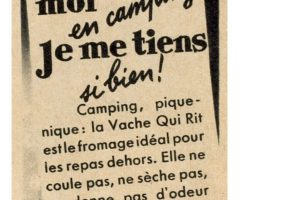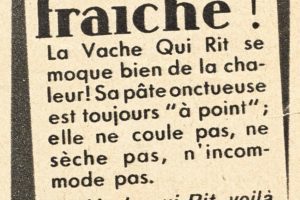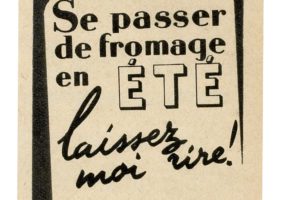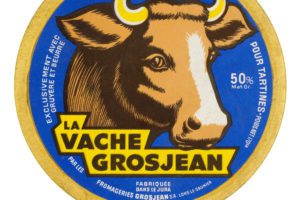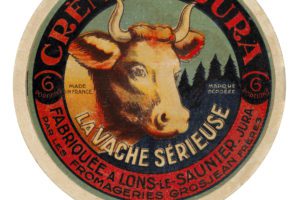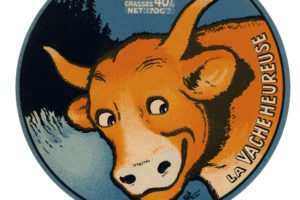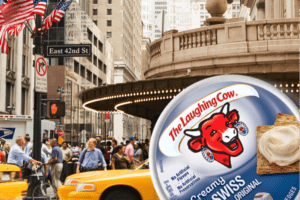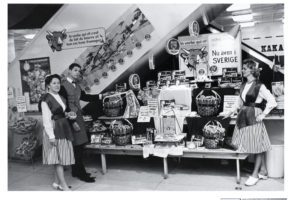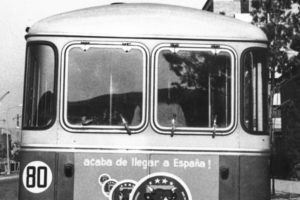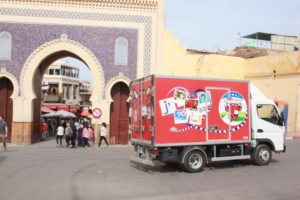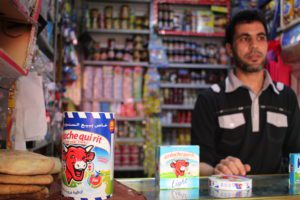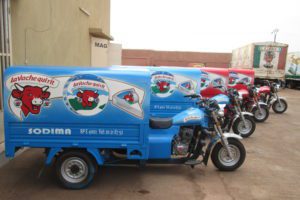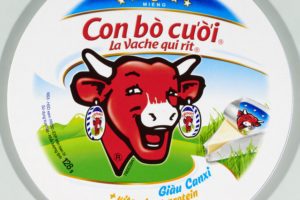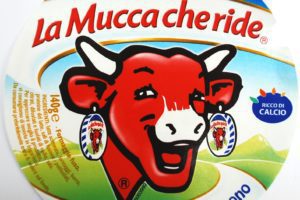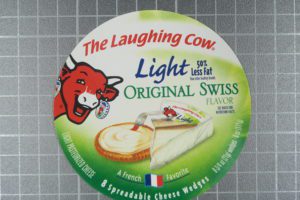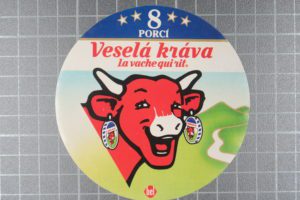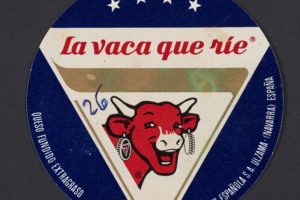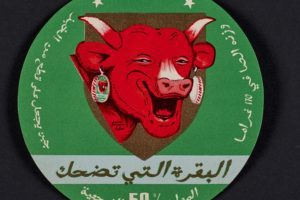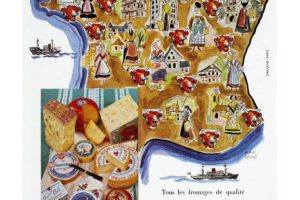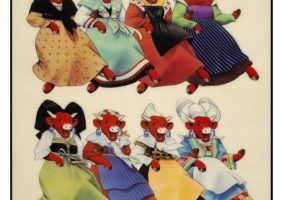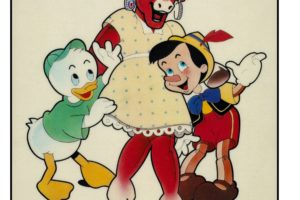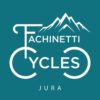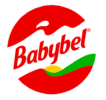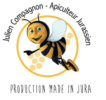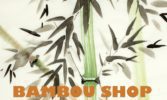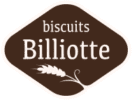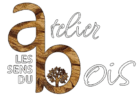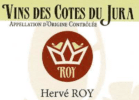The saga of The Laughing Cow® began a century ago. Today, it is the most consumed cheese in the world. Here is a look back at a worldwide success.
Once upon a time…
This story begins in the small village of Chambéria. Between Lons-Le-Saunier and Bourg-en-Bresse, the landscapes of meadows and forests are typical of what is called in the Jura “little mountain”. Cheese has been made here for centuries. Jules Bel, the founder of the Bel dynasty, was born in 1842. Ambitious, he took out a loan in 1865 and set up in Orgelet as a master cheese refiner. He set up his business in the cellars of a former Capuchin convent. In 1868, he perfected a process for ripening Gruyère cheese by maturing it in a warm cellar, before stabilising it in a cold cellar, which allows the cheese to travel longer, and therefore further. His business prospered and Jules prepared his sons Henri and Léon from a very young age for the demands of his difficult profession.
In 1897, he handed over the reins to them. They were respectively 27 and 19 years old. The company then became “Bel Frères”. The duo relocated the company to Lons-Le-Saunier in 1898, to take advantage of the railway and the proximity of the Montmorot saltworks.
After Henri’s withdrawal from business four years later, Léon Bel found himself alone at the helm and demonstrated his entrepreneurial abilities; he developed his sales force by recruiting representatives to head sales outlets throughout France.
Léon Bel and World War I
Léon Bel was drafted on 7 August 1914. He was assigned to the squadrons of the “Train”, the army’s automobile service which provided logistics and supplies for the battalions. To recognise from a distance the trucks delivering their units, the soldiers decorated them with humorous insignia. Lieutenant Lemarchand, in charge of the RVF B70 (Fresh Meat Supply), commissioned a drawing from the famous animal illustrator Benjamin Rabier, who created a laughing ox. An inspired “poilu” calls it “La Wachkyrie”, an irreverent spike to Wagner’s Walkyrie, a cornerstone of German culture.
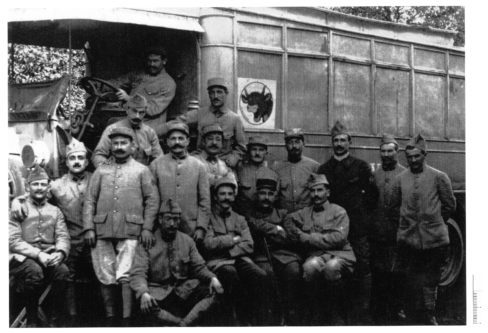
The first Laughing Cow®.
Back in Lons in 1919, Léon Bel took back the reins of his company, determined to relaunch his commercial activity, and moved to a new workshop in the Rue de l’Aubépin. Far-seeing, Léon Bel combined his memory of the smiling ruminant with the idea of a new product, a modern processed cheese with an exceptional shelf life, thanks to its packaging in hermetically sealed metal tins.
He hired Emile Graf, the Swiss importer of the processed cheese recipe, as technical director. On 16 April 1921, the trademark La Vache qui rit® is registered. The first illustration on the box is also registered: a hilarious cow, shown standing, made by the Lyon advertising firm Ramboz.
From the metal box to the portion
Faced with the rapid success of his new brand, Léon Bel equipped the “Aubépin” workshop with modern machines in 1924. These machines made it possible to increase production while improving the quality of the product and the working conditions of the workers.
It was also an opportunity to develop the portion casting machine: The Laughing Cow ® is now sold in small triangular portions, wrapped in tin paper and placed in cardboard boxes. This innovation ensures that the cheese keeps just as well as the metal box. In the very first year, 12,000 boxes sell daily.
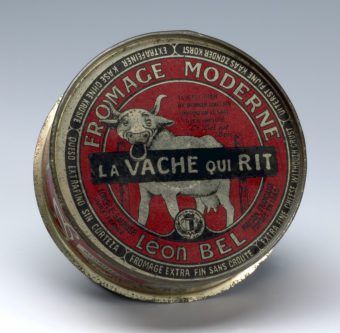
The birth of a brand
Léon Bel is not satisfied with the visual representing his brand. He wants of a real mascot and approaches several designers. Benjamin Rabier, again, stands out with his cute mischievous cow. In 1923, Léon Bel took this drawing to the studios of the Lyon printer Vercasson. With Benjamin Rabier’s agreement, he asked the printer to dye this cow’s head in red and, on his wife’s advice, to adorn it with earrings in the shape of a Laughing Cow® box, thus creating an image that reproduces itself ad infinitum.
In November 1923, Léon Bel ordered several thousand large posters from Vercasson. In 1924, he ordered twice as many. An icon was born.

And Rabier created The Laughing Cow®.
When Léon Bel chose his cow in 1923 to illustrate the boxes of Laughing Cow®, Benjamin Rabier was in full glory. Since the end of the 19th century, the work of this master of animal comedy was being published in the greatest illustrated publications. His duck Gédéon, also born in 1923, is a triumph and became the hero of seventeen albums. In a text published in 1902, Rabier recounted the genesis of his laughing cow:
“Drawing animals is easy; giving them a sad or jovial expression, it’s all there. But if you can train a dog to sit pretty, (…) it takes a patience like no other to make it laugh or cry. It may be possible with a dog, but making a cow laugh! (…) I had rented a cow and her calf from my milkman. I started with the calf, thinking it would be more sensitive, being younger. Well, not at all! It was the mother who laughed first, happy to see me playing with her child. “A.C.
A new factory in Lons
The industrial tool was not left behind. Léon Bel quickly understood that the Aubépin installations would soon be obsolete. In 1925, he had a new factory built in Lons, this time on the Boulevard Jules Ferry. Inaugurated in 1926, it became a high-performance production unit, with warehouses, cardboard factory and integrated advertising offices, designed to produce 120,000 boxes a day. The plant was regularly modernised and is still in operation.
The machine was running. It wouldn’t stop.
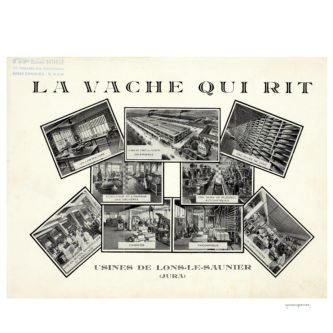
From publicity to communication
Léon Bel very quickly perceived the importance of communication in the growth of The Laughing Cow®.
He was one of the first to create a “Publicity” office. The Laughing Cow® was everywhere, in the press as well as on the walls of grocery shops. In 1931, Léon Bel even launched himself into radio advertising with the song C’est La Vache qui rit® by Jean Rodor, performed by the aptly named Constantin le Rieur.
When the crisis of the 1930s hit, and despite a big drop in activity, the company continued to prepare for the future. Léon Bel refused to adopt a policy of belt tightening. He maintained the brand’s reputation through sustained advertising investment.
The crisis of the 1930s
The company faced the challenges by diversifying its activities. Léon Bel widened the product range and introduced new cheeses, such as Babybel® in 1933 or La Petite Marmite au Fromage, an ready-made broth in portions made from processed cheese in 1934. From 1934 onwards his dairies produced a whole range of cheeses, proudly bearing the image of the Red Cow: Edam, Gouda, Mimolette, Saint-Paulin, Gorgonzola. In 1940, the company acquired the Groupe des Laiteries de l’Ouest: 6 plants in Sarthe and Maine-et-Loire.
Competition and counterfeiting: the price of success
Competitors existed in the processed cheese market, such as Graf and Picon. But other unscrupulous cheese makers tried to copy the image of The Laughing Cow® by launching more than 150 counterfeits.
The longest and most complex battle began in 1926 when the Grosjean cheese dairies, also based in Lons, put down La Vache Sérieuse. From the 1950s onwards, Grosjean hijacked the film “Le congrès du rire” (The congress of laughter) and affirmed that “Laughter is the hallmark of man, seriousness is the hallmark of the cow”. The hostilities were launched! They would end up in court. Grosjean attacking Bel… for counterfeiting, accusing him of having launched a brand with a name too close to The Serious Cow: The Happy Cow. In 1957, Bel counter-attacks and Grosjean is forced to rename his cheese “La Vache Grosjean”. Bel had won his lawsuit, which remains, 50 years on, a case studied in business schools.
Robert Fiévet the builder
Once more, the war slowed the company’s development, but production continued. In 1941, Robert Fiévet, Léon Bel’s son-in-law, became CEO of Fromageries Bel.
For more than half a century, Robert Fiévet would drive the company’s meteoric acceleration, multiplying its production by 40.
In France, this led to the extension of existing factories, the creation of research centres – Lons in 1960, Vendôme in 1969 – the setting up of new production units and, last but not least, the conquest of the international market.
A round box around the world
In 1929, Fromageries Bel set up a production plant in Southampton, UK and a subsidiary, Bel Cheese Company, thus opening up to the British and Northern European markets. From 1933 onwards, the same strategy and configuration was adopted in Belgium, then the metropolis of the Belgian Congo, and gradually in other European countries.
After the Second World War, Robert Fiévet opened subsidiaries and built factories on all 5 continents. The results were not long in coming: by the 1960s, The Laughing Cow®, Bonbel® and Babybel® appeared in 60 countries. In 1964 Bel was awarded the Oscar for exports.
In 1953, a factory opens in Denmark to supply various foreign countries, particularly Canada, which becomes an important market.
The Laughing Cow® also met with success in the United States. The Laughing Cow® has been manufactured in Kentucky since 1970.
In 1974, it arrived in Africa via Tangier. The factory provides deliveries to the whole continent and Madagascar.
In the 2000s, The Laughing Cow® conquered the East and Asia. In Vietnam, a portion of it is readily presented as a welcome gift to guests. In the United States, The Laughing Cow® is popular as a light or onion-flavoured versions. In Eastern Europe, it is preferred with paprika.
Sixteen factories manufacture The Laughing Cow® worldwide. The largest is in Tangier and the smallest, the size of a football pitch, is in the Ivory Coast.
She advertises
To accompany the post-war economic expansion, Robert Fiévet entrusted the advertising destiny of the company to the Chavane agency, directed by the famous illustrator Hervé Baille, then Montfort and TWBA.
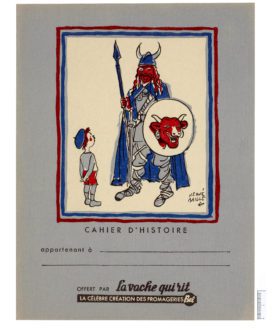
In 1950, The Laughing Cow® appeared in cinema advertisements: in Le Cordon Bleu where the actress Pauline Carton, a celebrity at the time, praised Bel cheeses, then Le Congrès du rire, a cartoon by Paul Grimaud (Le Roi et l’Oiseau). It appears in the press, in the streets, in the metro and on buses. It’s present in radio programmes and games (La Vache qui rit® au Paradis des Animaux). Proclaimed “Friend of the children”, she appears on schoolchildren’s outfits, notebook covers and blotters.
A new look for a new era
In 1955, Robert Fiévet was faced with a delicate situation: while going through a periodic consumer survey, he learns that his mascot was no longer popular.
The Laughing Cow® was then at a turning point in its history: it was about to proudly display a recipe with 50% fat content and easier to spread.
She was given a makeover for the occasion. They softened her features and dulled her horns. On the label, she appeared in the centre of a golden coat of arms topped with four stars, a sign of quality. A blue and white stripe now appeared around the box. Finally, a red tab makes it easier to open the portion.
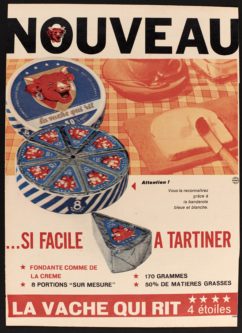
Large advertising campaigns
In 1968, French television starts broadcasting advertising films. The Laughing Cow® is once again a pioneer.
Carried away by the breath of freedom of 1968, it quickly found its feet with adaptable and intelligent campaigns. The Laughing Cow® launched a new campaign with the designer Jacques Parnel. Astonished gourmets discover it in full length: The Laughing Cow®, without any complexes, wearing Levi jeans, playing the guitar, going on a backpacking adventures, dancing in Alsatian or Normandy costume. It embodies its era, its aspirations and its antagonisms.
Crazier still, the next campaign invented the community of “Vachequiriphiles who have the wisdom to make themselves healthy by feasting”.
In 1980, television takes off. The Laughing Cow® is humorously inspired by big show advertising with “Casting”, a spot created by the TBWA agency. Calm and generous, she becomes a diva like no other: The Laughing Cow® wins the role of “star of the cheese” with flying colours in the face of competition from cows that fail because they are “too typical” or “too commonplace”.
In the 1990s, marked by the Gulf War, the era of glitter came to an end. More traditional values are back. In the new advertising films, a fighter pilot straight out of Top Gun takes a fascinated little boy by the hand and a father teaches his daughter to ride a bicycle. The transmission is highlighted: Léon Bel’s portioned cheese already has three generations of consumers.
When, in 2001, the advertising message leaned on the brand’s awareness among consumers with this question: “Why does The Laughing Cow®, laugh?” the impact was enormous.
Around the planet, some 2 300 little triangles are enjoyed every thirty seconds. Their recipe is adapted to different cultures, different markets, but the fundamentals of Léon Bel are still there. The century-old Jura cheese is ready to meet the future.
Proud of its roots
In 1985, the Jura landscape made a comeback on the boxes of Laughing Cow®. Present on the label since 1923, it had disappeared during the major makeover of 1955. In this new version, La Vache now laughs in front of a landscape of gently rolling mountains and a meadow where a river of milk meanders through. In 1998, the new rounding of the band bearing the label gives even more relief to this Edenic setting. In 2007, the river of milk, widened, comes to the fore.
Since 2017, a slight movement animates the cow’s earrings and gives it a more natural look, while meadows and mountains are adorned with grass so realistic that you want to touch it. The river disappears, but a sidebar proclaims the cheese’s fidelity to its roots: “Made in the Jura since 1921”.
Axelle Corty
